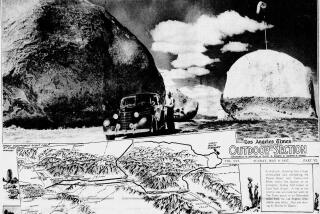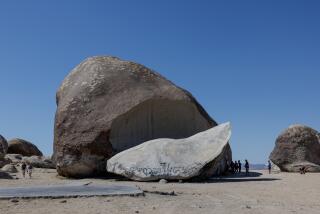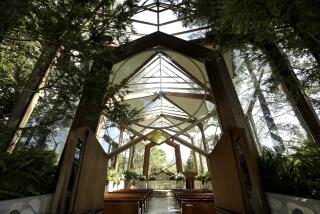Wall at Mission to Shed Cocoon of Scaffolding
- Share via
SAN JUAN CAPISTRANO — For eight years, tourists visiting the Great Stone Church at Mission San Juan Capistrano have had to peer through a blind of ugly scaffolding to see the historic landmark.
But today, the church’s towering and unsightly grid--installed around the decaying church for safety purposes and to prevent further damage--will be gone and the east wall’s new and preserved look unveiled to the public.
“You won’t believe the difference in appearance,” said project manager John Loomis, a historical architectural expert from the 30th Street Architects in Newport Beach. “It’s a big change.”
For a week, construction crews have been removing scaffolding from the east wall level by level and have put the final touches on the church’s stonework. Workers have created an internal structure to support the building and save its stonework.
Construction on the Great Stone Church began in 1797 and was completed in 1806. Since the church’s collapse during an earthquake in 1812, little work has been done to preserve or restore it.
“We discovered we were just in the nick of time,” mission administrator Jerry Miller said. “When we got into the wall, we saw some strange things.”
Inside the 5-to-6-foot-thick wall, construction crews discovered ivy root balls, owls’ nests and rodent burrows. In addition, the wall had generally eroded from years of abuse from the elements, creating a cavity in the center. The mortar between the stones had deteriorated into a dusty sand composition as well.
“The church’s walls were always intended to be covered by a roof, but for nearly two centuries they’ve been exposed, and water has seeped in and eroded the stonework,” Loomis said.
To secure the crumbling wall, crews stabilized it with an internal steel support system and reinforced concrete bond beams. A drainage system at the top of the wall was also installed.
For the stonework, a group of graduate students from the University of Pennsylvania worked to restore the wall’s paint, plaster and stone to its original state. Tuff, stone of volcanic origin, was used to replace carved and decorative stone that was missing or damaged.
“It should stand there for centuries,” Miller said of the east wall.
The mission has launched a $7-million fund-raising effort to pay for the church’s preservation. So far, $1.2 million has been spent on the project, including $260,000 for the east wall.
With the completion of the east wall, crews will move their attention to the west wall and domes which cover the altar and vestry areas, Miller said.
Mission officials hope that by the time all construction is complete, the church will be an American Acropolis.
“This thing is a work of art,” Loomis said. “It’s unbelievable.”
More to Read
Sign up for Essential California
The most important California stories and recommendations in your inbox every morning.
You may occasionally receive promotional content from the Los Angeles Times.










